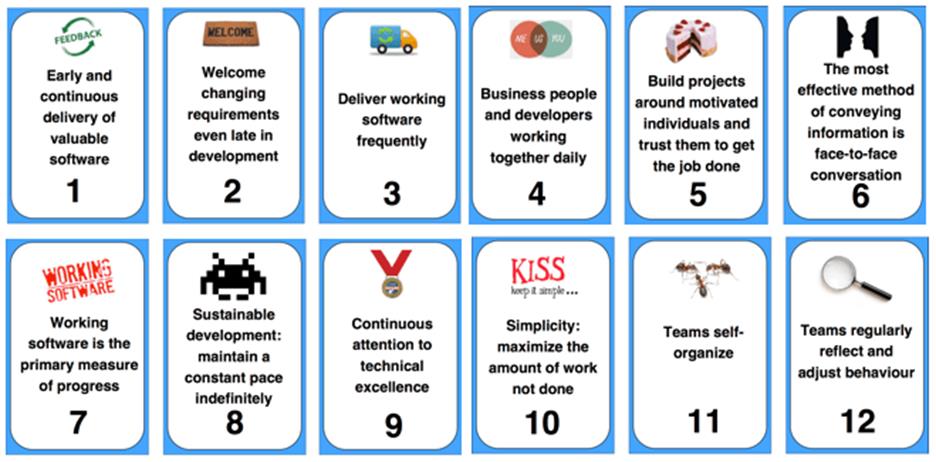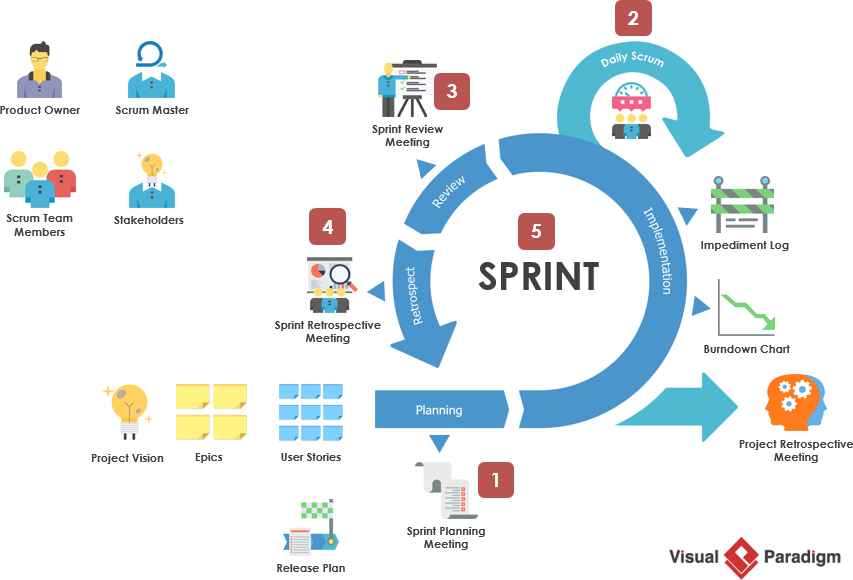Essentially understood as a management manifesto, and arguably more flexible than older management methods, Agile allows management teams to transcend the traditional sequential model and Get more done in a shorter amount of time. Essentially the Agile methodology described consists of 12 important principles that talk about communication, collaboration, the importance of software, and openness to change in the project.
And with 4 core values:
 Sources: hoangsyquy.blogspot.com
Sources: hoangsyquy.blogspot.com
12 keys important principles: 12 principles divided into 4 groups, each group has a different meaning. The principles divided into 4 groups, each group has a different meaning.
1. Agile principles of customer satisfaction
-Early and continuous delivery of valuable software
-Welcome changing requirements, even late in development
-Deliver working software frequently
2. Agile principles of quality
-Working software is the primary measure of progress
-Agile processes promote sustainable development. The sponsors, developers, and users should be able to maintain a constant pace indefinitely
-Continuous attention to technical excellence and good design enhances agility
3. Agile principles of teamwork
-Business people and developers must work together daily throughout the project
-Build projects around motivated individuals. Give them the environment and support they need, and trust them to get the job done
-The most efficient and effective method of conveying information to and within a development team is face-to-face conversation
-The best architectures, requirements, and designs emerge from self-organizing teams
4. Agile principles of project management
-Simplicity–the art of maximizing the amount of work not done–is essential
-At regular intervals, the team reflects on how to become more effective, then tunes and adjusts its behavior accordingly
Not only that, but Agile also has principles that businesses should prioritize to satisfy customers with their products. Examples are repeatability, increment, adaptation, process management, communication, value-based development.
Since it is an Agile software development process, it follows the principles of Agile. Scrum is a project management framework that is very widely applied, from simple projects to those with very complex requirements or even those that require a fixed time frame. Scrum transcends the traditional Waterfall model thanks to the following three roles: product owner, production team, development team. The deliverables of the project are divided into different phases, and it is called a Sprint, with the task of facilitating changes, tailoring solutions, and delivering the best results.

Scrum also owns a concept called Scrum Event, there are 5 events in the Scrum process: Sprint, Sprint Planning, Daily Scrum, Sprint Review, and Sprint Retrospective. With these events, Scrum helps to reduce unnecessary meetings, shorten the time for unnecessary debates and discussions. Events will terminate if the event’s objective is complete.
As mentioned above, because Scrum is developed based on Agile, it will have the same goal. In short, Scrum is a type of method and is within the Agile framework. Both are optimization of the value created for the customer through different stages. Despite their similarities, the two have distinct differences.
If Scrum has its characteristics such as: is a working model based on the basic principles of Agile, when implementing different projects, there is no need to change the process or organization, .. Agile is considered as a methodology with many principles, it may be necessary to change the process or organization when implementing different projects,…
Scrum is more popular than Agile, because Scrum is flexible, like how it can shorten projects, or for the development team to make unlimited changes based on customer requirements. Not only that, but Scrum also allows innovation and creativity to help the project reduce many risks, unexpected problems, increase productivity, and efficiency can also increase continuously.
In the 4.0 era, technology will be what holds a decisive role in the success or failure of businesses. The application of scientific and technological advances to enterprises, especially in project management. It will make a big difference in competitiveness compared to other enterprises in the market. UpDiagram’s templates like business, project management, marketing, etc. Are suggestions that you should try to exploit Scrum and Agile methods. Like other management methods or processes, Scrum and Agile have their distinct advantages and disadvantages.
But to apply Scrum and Agile effectively is not too difficult. If we know how to use a tool with core values (transparency, inspection, adaptability), track members clearly, connect people in the project. Then UpDiagram is a tool that satisfies those needs that condition. How to apply UpDiagram to exploit Scrum and Agile.
Contact support@updiagram.com for assistance. We are with you every step of the way.